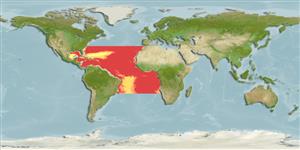>
Stomiiformes (Lightfishes and dragonfishes) >
Stomiidae (Barbeled dragonfishes) > Melanostomiinae
Etymology: Melanostomias: Greek, melan, -anos = black + Greek, stoma = mouth (Ref. 45335).
More on authors: Regan & Trewavas.
Environment: milieu / climate zone / depth range / distribution range
Écologie
marin bathypélagique; profondeur 620 - 760 m (Ref. 13608). Deep-water; 35°N - 22°S
Eastern Atlantic: Morocco south to Western Sahara and at Cameroon. Western Atlantic: USA south to Bahamas and from Venezuela to Brazil.
Taille / Poids / Âge
Maturity: Lm ? range ? - ? cm
Max length : 25.0 cm SL mâle / non sexé; (Ref. 37039)
Description synthétique
Clés d'identification | Morphologie | Morphométrie
Épines dorsales (Total) : 0; Rayons mous dorsaux (Total) : 15; Épines anales: 0; Rayons mous anaux: 17 - 18. Body moderately elongate and slender. Barbel has slender stem and narrow, flattened distal tip. Preorbital and suborbital luminous organs are absent. Black in color. Barbel stem is black, tip of barbel unpigmented (Ref. 37039).
Life cycle and mating behavior
Maturité | Reproduction | Frai | Œufs | Fécondité | Larves
Gibbs, R.H. and M.A. Barnett, 1990. Melanostomiidae. p. 308-337. In J.C. Quero, J.C. Hureau, C. Karrer, A. Post and L. Saldanha (eds.) Check-list of the fishes of the eastern tropical Atlantic (CLOFETA). JNICT, Lisbon; SEI, Paris; and UNESCO, Paris. Vol. 1. (Ref. 4468)
Statut dans la liste rouge de l'IUCN (Ref. 130435: Version 2024-2)
Menace pour l'homme
Harmless
Utilisations par l'homme
Outils
Articles particuliers
Télécharger en XML
Sources Internet
Estimates based on models
Preferred temperature (Ref.
123201): 6.2 - 11.2, mean 7.6 °C (based on 18 cells).
Phylogenetic diversity index (Ref.
82804): PD
50 = 0.5000 [Uniqueness, from 0.5 = low to 2.0 = high].
Bayesian length-weight: a=0.00302 (0.00116 - 0.00786), b=3.12 (2.89 - 3.35), in cm total length, based on LWR estimates for this (Sub)family-body shape (Ref.
93245).
Niveau trophique (Ref.
69278): 4.2 ±0.73 se; based on food items.
Résilience (Ref.
120179): Milieu, temps minimum de doublement de population : 1,4 à 4,4 années (Preliminary K or Fecundity.).
Fishing Vulnerability (Ref.
59153): Low vulnerability (21 of 100).
